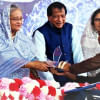Make education accessible for children with disabilities

According to the National Survey on Persons with Disabilities 2021 by the Bangladesh Bureau of Statistics (BBS), there are about 4.5 million persons with disabilities in Bangladesh. This large population remains mostly excluded when it comes to access to education. While Bangladesh is nearing the goal of full primary school enrolment, only about 41 percent of children with disabilities of primary-school-going age (6-10 years) are enrolled in schools. The difference is partly due to their delayed admission. The rate is lower than the national average of 97 percent, and enrolment sharply drops to 24 percent for the 11-16 age group. So not only do children with disabilities have a low school enrolment rate and a delayed start, but they also tend to drop out early.
Inclusive development is stipulated in our constitution. The Sustainable Development Goals (SDGs) also seek to leave no one behind in the process of holistic development. Thus, excluding children with disabilities from education is tantamount to denying their constitutional and humanitarian rights.
An ongoing study by the Brac Institute of Governance and Development (BIGD), in collaboration with researchers from Cambridge University, found that the parents of children with disabilities value their access to mainstream education. The greatest interest was observed in the households where both parents work. These parents do not have the opportunity to spend much time on their children's education and self-care needs. Most parents, particularly those working outside, often cannot make the necessary adjustments for a more inclusive household infrastructure due to financial limitations or simply the lack of knowledge and awareness. When both parents work, it is difficult to leave their child with a disability at home alone. Access to good primary education would not only enhance the skills of their children, but also provide reliable day-care support.
In this context, Bangladesh has some commendable laws in place. The most important of those laws states that no school can discriminate against a child based on their disability in the admission process, according to the Rights and Protection of Persons with Disabilities Act, 2013. The BIGD study found that government primary schools generally follow this policy. Substantial difficulties in educating children with disabilities still remain.
For example, when a child with disability does not understand a concept or faces difficulties in class, without relevant training, the teacher usually struggles to deal with the situation. Also, teachers have limited time during each class to ensure that all children get quality education. It is difficult to pay attention to any child that needs special care, especially with the standard 1:35 teacher-student ratio. The special care could be related to the ongoing lesson in class (for example, frequently checking if the child in question is following the class), emergency healthcare, prevention of bullying, or even self-care needs (such as taking them to the bathroom). It gets difficult for one teacher to handle these multifaceted issues while keeping the quality of education intact. The parents of children with disabilities also raised concerns about these issues in school.
However, there have been some positive developments recently. To comply with the law and the SDGs, about 38 percent of schools now have entrances with ramps for wheelchair users and toilets with high commodes for ease of access. However, there are still gaps. For example, in some cases, schools with ramps still have the bottom frame (choukath) of the door, preventing wheelchair access to school buildings or classes without help. In many cases, accessing high commodes requires climbing steps, again making it difficult for a child who has difficulty walking.
One could argue that given the resource-intensive nature of their education, special schools could be built for children with disabilities. But children get their first and most expansive exposure to the outside world at school. Keeping children away from mainstream education means hindering their connection to the real world. When they learn and grow with other children, they gain critical social skills, confidence, and networks. It also raises awareness and a desire for inclusion among teachers, other children, and society as a whole.
Achieving inclusive education in Bangladesh will require learning from the teachers, students, and parents most closely involved with dealing with children with disabilities. Teachers need to be trained regularly. Interactive sessions between parents and teachers are also necessary at the beginning of each school year to ensure that teachers are well aware of the needs of the children they teach.
Ensuring inclusive education requires substantial investment and continuous learning. So, the improvements are likely to be gradual. Getting the basics right should be the priority; the more challenging targets, such as introducing inclusive teaching materials like braille, can be addressed in the longer term. But it will require the sustained commitment of policymakers and an application of focused, clever strategies. We hope the government and other stakeholders strive to invest in inclusive education in Bangladesh.
Maliha Noshin Khan and Marzuk AN Hossain are research associates at the Brac Institute of Governance and Development (BIGD).
Md Kamruzzaman is senior research associate at BIGD.

 For all latest news, follow The Daily Star's Google News channel.
For all latest news, follow The Daily Star's Google News channel. 









Comments